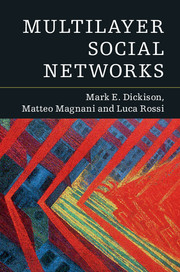10 - Future Directions
from PART IV - CONCLUSION
Published online by Cambridge University Press: 05 July 2016
Summary
In order to complete the range of thy experience, I conduct thee downward to the lowest depth of existence, even to the realm of Pointland, the Abyss of No dimensions.
– The SphereMultilayer networks constitute an extremely active field of research. While we were writing this manuscript, we had to change, update, and amend the text many times because of all the relevant research and ideas that were being published. Despite all our efforts, we are certain that much new research, and possibly somemajor advances,will be published before this book becomes available.
This should probably be considered a good sign and will not undermine the main goal of the volume: besides providing an introduction to multilayer social networks and a set of initial concepts and metrics to introduce the reader to this exciting area, our main objective was to suggest an initial organization of the material in this area, which is still spread across multiple research fields that have only recently begun talking regularly to each other.
Getting to the topic of this chapter, as it often happens when research areas are extremely heterogeneous and are being developed autonomously by scholars as different as physicists, computer scientists, and sociologists, it is not easy to identify a single clear direction for future research, and even trying to provide a frame to what exists poses serious challenges. We often had to make hard choices to propose a structure that was as homogeneous as possible and still cover the major areas of research – and we are aware that we have not completely reached this objective.
Although we are fully aware of all these limitations, and although we do not think that this work could be as comprehensive as some of the existing volumes on traditional social network analysis or network theory, we think that this kind of work can help a diverse and dispersed community to be more aware of what is going on and to settle some key concepts before moving forward. Following this ambition, we have decided to conclude this book by outlining some of what we think might constitute future research trends of broad interest in this field.
- Type
- Chapter
- Information
- Multilayer Social Networks , pp. 169 - 178Publisher: Cambridge University PressPrint publication year: 2016



